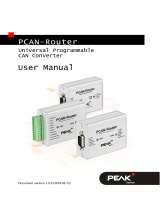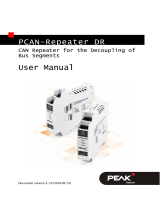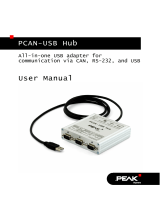Page is loading ...

Universal, Programmable Converter
for CAN FD and CAN
User Manual
PCAN-Router FD
Document version 2.1.0 (2020-09-29)

PCAN-Router FD – User Manual
2
Relevant Products
Product Name Model Part Number
PCAN-Router FD 2 D-Sub connectors IPEH-002214
from SN 10000
PCAN-Router FD Screw terminal block (Phoenix) IPEH-002215
from SN 1000
PCAN® is a registered trademark of PEAK-System Technik GmbH. CANopen® and
CiA® are registered community trade marks of CAN in Automation e.V.
All other product names mentioned in this document may be the trademarks or
registered trademarks of their respective companies. They are not explicitly marked
by “™” and “®”.
Copyright © 2020 PEAK-System Technik GmbH
Duplication (copying, printing, or other forms) and the electronic distribution of this
document is only allowed with explicit permission of PEAK-System Technik GmbH.
PEAK-System Technik GmbH reserves the right to change technical data without
prior announcement. The general business conditions and the regulations of the
license agreement apply. All rights are reserved.
PEAK-System Technik GmbH
Otto-Roehm-Strasse 69
64293 Darmstadt
Germany
Phone: +49 (0)6151 8173-20
Fax: +49 (0)6151 8173-29
www.peak-system.com
info@peak-system.com
Doc
ument version 2.1.0 (2020-09-29)

PCAN-Router FD – User Manual
3
Contents
1 Introduction 5
1.1 Properties at a Glance 5
1.2 Prerequisites for Operation 6
1.3 Scope of Supply 7
2 Connectors and Operating Elements 8
2.1 D-Sub Connectors (IPEH-002214) 8
2.2 Screw Terminal Block (IPEH-002215) 10
2.3 Status LEDs 12
3 Operation 13
4 Hardware Configuration 14
4.1 4-Bit Coding 14
4.2 Supply of External Devices via the D-Sub
Connector (IPEH-002214) 17
4.3 Two Additional Digital Inputs 19
4.4 Termination of the CAN Buses 21
5 Creating Own Firmware 23
5.1 Library 24
6 Firmware Upload 25
6.1 System Requirements 25
6.2 Preparing Hardware 25
6.3 Firmware Transfer 27
7 Technical Specifications 30
Appendix A CE Certificate 34

PCAN-Router FD – User Manual
5
1 Introduction
The PCAN-Router FD allows the connection to two CAN FD or CAN
buses. Based on a ARM Cortex M4F microcontroller, the module‘s
behavior and the data routing between both CAN FD channels is
freely programmable. In particular, the module allows the
conversion from CAN to CAN FD or vice versa. This makes it easy to
accomplish the integration of CAN FD applications into existing
CAN 2.0 networks.
Using the programming library and the GNU compiler for C and
C++, a firmware is created and then transferred to the module via
CAN. On delivery, the PCAN-Router FD is provided with a demo
firmware. The corresponding source code is included as example in
the scope of supply.
The module is installed in an aluminum profile casing, and is
shipped in versions with two D-Sub connectors or a screw terminal
block.
1.1 Properties at a Glance
NXP LPC4078 microcontroller
(ARM Cortex M4 with FPU, 120 MHz)
On-chip 4 kByte EEPROM
8 MByte SPI flash
Two High-speed CAN channels (ISO 11898-2)
Comply with CAN specifications 2.0 A/B and FD
CAN FD support for ISO and Non-ISO standards
CAN FD bit rates for the data field (64 bytes max.) from 40
kbit/s up to 12 Mbit/s

PCAN-Router FD – User Manual
6
CAN bit rates from 40 kbit/s up to 1 Mbit/s
NXP TJA1043T CAN transceiver with wake-up
Status signaling with two 2-color LEDs
Connections via two 9-pin D-Sub connectors or one 10-pole
screw terminal block (Phoenix)
RS-232 connector for serial data transfer
I/O-connection:
One digital input (low-active)
One digital output (Low-side switch, max. 600 mA)
2 additional digital inputs alternatively to RS-232 (low-active)
Aluminum casing, optional with DIN rail fixing option available
Voltage supply from 8 to 30 V
Extended operating temperature range from -40 to 85 °C
(-40 to 185 °F)
New firmware can be loaded via CAN interface
1.2 Prerequisites for Operation
Power supply in the range of 8 to 30 V DC
For uploading a new firmware via CAN:
CAN interface of the PCAN series for the computer
(e.g. PCAN-USB)
Operating system Windows 10 and 8.1 (32-/64-bit)

PCAN-Router FD – User Manual
7
1.3 Scope of Supply
PCAN-Router FD in aluminum casing
IPEH-002215: mating connector (Phoenix)
Windows® development package with GCC ARM Embedded,
flash program, and programming examples
Library with programming examples
Manual in PDF format

PCAN-Router FD – User Manual
8
2 Connectors and Operating
Elements
The following connections can be used depending on the version:
2 x 9-pin D-Sub connectors (m) (IPEH-002214)
10-pole screw terminal block (IPEH-002215)
I/O pin: digital output, digital input
RS-232 interface for serial data transmission;
alternatively 2 x digital inputs via hardware configuration
(see chapter
4.3 Two Additional Digital Inputs on page 19
)
Boot input for activation of the CAN bootloader for firmware
upload (see chapter
6 Firmware Upload on page 25
)
The following subsections describe each connector assignment.
2.1 D-Sub Connectors (IPEH-002214)
Figure 1: D-Sub connectors CAN1 left and CAN2 right

PCAN-Router FD – User Manual
9
The two D-Sub connectors are used for the CAN FD channels CAN1
and CAN2. The CAN lines (CAN_H, CAN_L) are laid out correspon-
ding to the CiA® 303-1 specification.
The power supply of the PCAN-Router FD can be done via both D-
Sub connectors. The supply connections U
b1
and U
b2
are connected
internally in a non-reactive configuration. This means that also
different power sources can be connected.
With the D-Sub connector CAN1, the bootloader for the firmware
upload can be additionally activated via pin 6. The channel CAN1
contains additionally, alternatively to the RS-232 interface, two
digital inputs named Din1 and Din2, which can be evaluated by the
microcontroller. For more information, please refer to chapter
4.3
Two Additional Digital Inputs on page 19
.
Figure 2: Pin assignment D-Sub connector
CAN1
Pin Identifier Function
1 +5V opt. 5-Volt supply external device (optional)
1
2 CAN1_L CAN FD channel 1 Low
3 GND Ground
4 RxD (Din1) RS-232 RxD (alternative digital input Din1)
2
5 Shield Shield
6 Boot (High level) Activation CAN bootloader
3
7 CAN1_H CAN FD channel 1 High
8 TxD (Din2) RS-232 TxD (alternative digital input Din2)
2
9 U
b1
Power supply 8 - 30 V DC
1
See section
4.2 on page 17
2
See section
4.3 on page 19
3
Attention! Risk of short circuit! See note in
6.2 on page 25

PCAN-Router FD – User Manual
10
CAN2
Pin Identifier Function
1 +5V opt. 5-Volt supply external device (optional)
1
2 CAN2_L CAN FD channel 2 Low
3 GND GND
4 - Not used
5 Shield Shield
6 - Not used
7 CAN2_H CAN FD channel 2 High
8 Din0 / Dout Digital input Din0,
digital output Dout (600 mA)
9 U
b2
Power supply 8 - 30 V DC
2.2 Screw Terminal Block (IPEH-002215)
Figure 3: Screw terminal block left with terminals for CAN1 and CAN2
The screw terminal block is used for the CAN FD channels CAN1
and CAN2. The bootloader for the firmware upload can be

PCAN-Router FD – User Manual
11
additionally activated via pin 7. Alternatively to the RS-232 interface,
two digital inputs named Din1 and Din2 can be activated, which can
be evaluated by the microcontroller. For more information, please
refer to chapter
4.3 Two Additional Digital Inputs on page 19
.
Figure 4: Screw terminal block (Phoenix)
Mating connector Phoenix Contact MC 1.5/10-ST-3.81
Terminal Identifier Function
1 U
b
Power supply 8 - 30 V DC
2 GND Ground
3 CAN1_L CAN FD channel 1 Low
4 CAN1_H CAN FD channel 1 High
5 CAN2_L CAN FD channel 2 Low
6 CAN2_H CAN FD channel 2 High
7 Boot Activation CAN bootloader (High level)
4
8 Din0 / Dout Digital input Din0,
digital output Dout (600 mA)
9 RxD (Din1) RS-232 RxD (alternative digital input Din1)
5
10 TxD (Din2) RS-232 TxD (alternative digital input Din2)
5
4
Attention! Risk of short circuit! See note in
6.2 on page 25
5
See section
4.3 on page 19

PCAN-Router FD – User Manual
12
2.3 Status LEDs
Routing firmware is pre-installed on delivery. Therefore, the LEDs
CAN1 and CAN2 light up between green and orange on incoming
CAN messages. Additionally, they light up orange when the
bootloader is activated (see
6.2 Preparing Hardware on page 25
).
Additional LED functions can be programmed with your own
firmware. More details can be found in the programming examples
supplied.

PCAN-Router FD – User Manual
13
3 Operation
The PCAN-Router FD is activated by applying the supply voltage to
the respective connectors (see chapter
2 Connectors and Operating
Elements on page 8
). The firmware in the flash memory is
subsequently run.
On delivery, the PCAN-Router FD is equipped with an example
firmware which forwards CAN messages 1:1 between both CAN FD
channels (CAN FD ISO, 500 kbit/s nominal, 4 Mbit/s data). An inco-
ming CAN message causes a change between green and orange of
the LED status indication for the respective CAN channel.
The source code for the example firmware 1_ROUTING and further
examples can be downloaded from the following link:
www.peak-system.com/quick/DLP-DevPack
More about firmware can be found in chapter
5 Creating Own
Firmware on page 23
.

PCAN-Router FD – User Manual
14
4 Hardware Configuration
For special applications, several settings can be done on the circuit
board of the PCAN-Router FD by using solder bridges.
4-bit coding of the hardware for polling by the firmware (see
section
4.1 4-Bit Coding below
)
D-Sub version only:
Supply of external devices with 5 Volts via the D-Sub connector
(see section
4.2 Supply of External Devices via the D-Sub
Connector (IPEH-002214) on page 17
)
Use of two additional digital inputs (Din1, Din2) instead of the
serial RS-232 interface (see section
4.3 Two Additional Digital
Inputs on page 19
)
Termination of the CAN buses with 120 (see section
4.4
Termination of the CAN Buses on page 21
)
4.1 4-Bit Coding
The board has four coding solder bridges to assign a permanent
state to the corresponding input bits of the microcontroller. The four
positions for coding solder bridges (ID 0 - 3) are each assigned to
one port of the microcontroller LPC2194/01 (μC). A bit is set (1) if the
corresponding solder field is open.
A concrete application is the identification of a PCAN-Router FD on
the CAN bus during a firmware upload, especially if several routers
are connected and in operation.
The status of the ports is relevant in the following cases:
The loaded firmware is programmed so that it reads the status
at the corresponding ports of the microcontroller. For example,

PCAN-Router FD – User Manual
15
the activation of certain functions of the firmware or the coding
of an ID is conceivable here.
For a firmware upload via CAN the PCAN-Router FD is identified
by a 4-bit ID which is determined by the solder bridges (default
setting: ID15, all solder fields open).
Solder Field
ID0 ID1 ID2 ID3
Binary Digit
0001 0010 0100 1000
Decimal Equivalent
1 2 4 8
Do the following to activate the coding solder bridges:
Danger of short circuit! Take great care when soldering to
avoid short circuits.
Attention! Electrostatic discharge (ESD) can damage or destroy
components on the card. Take precautions to avoid ESD.
1. Unscrew the housing on both sides.
2. For D-Sub version only:
Remove the screws next to one of the two D-Sub
connectors.
3. Pull out the board.
4. Solder the solder bridge(s) on the board according to the
desired setting.
Figure 5 shows the positions of the solder fields on the
boa
rd. The tables below contain the possible settings.
5. Carefully put the board back into the housing.
6. For D-Sub version only:
Reinsert the two screws at the D-Sub connector.
7. Screw the two sides of the housing back together.

PCAN-Router FD – User Manual
16
Figure 5: Position of the coding solder fields
Position 0 1 2 3
Port μC
P0.4 P0.5 P0.6 P0.7
Solder Field Status
Port Status
Low
High

PCAN-Router FD – User Manual
17
4.2 Supply of External Devices via the D-
Sub Connector (IPEH-002214)
External devices with low power consumption (e.g. bus converters)
can be supplied via the CAN connection CAN1 and CAN2. With a
solder bridge for each CAN channel on the board of the PCAN-
Router FD a voltage of 5 Volt can be applied to pin 1 of the D-Sub
connector. The current consumption may not exceed 100 mA per
CAN connection.
Do the following to activate the 5-Volt supply:
Danger of short circuit! Take great care when soldering to
avoid short circuits.
Attention! Electrostatic discharge (ESD) can damage or destroy
components on the card. Take precautions to avoid ESD.
1. Unscrew the housing on both sides.
2. Remove the screws next to one of the two D-Sub
connectors.
3. Pull out the board.
4. Solder the solder bridge(s) on the board according to the
desired setting.
Figure 6 shows the positions of the solder fields on the PCB.
The
tables below contain the possible settings.
5. Carefully put the board back into the housing.
6. Reinsert the two screws at the D-Sub connector.
7. Screw the two sides of the housing back together.

PCAN-Router FD – User Manual
18
Figure 6: Position of the solder fields for the supply of external devices
(for D-Sub connector CAN1 on the left, for CAN2 on the right)
5-Volt Supply
D-Sub Connector
None
(Default)
Pin 1
CAN1 (left)
CAN2 (right)

PCAN-Router FD – User Manual
19
4.3 Two Additional Digital Inputs
Instead of the preset serial RS-232 interface for the serial data
transmission, two additional digital inputs (Din1, Din2) can be
assigned to the corresponding pins or screw terminals
6
. The inputs
can be activated either by changing two 0-Ohm resistors or
alternatively by solder bridges.
Do the following to activate the digital inputs:
Danger of short circuit! Take great care when soldering to
avoid short circuits.
Attention! Electrostatic discharge (ESD) can damage or destroy
components on the card. Take precautions to avoid ESD.
1. Unscrew the housing on both sides.
2. For D-Sub version only:
Remove the screws next to one of the two D-Sub
connectors.
3. Pull out the board.
4. Move the two 0-Ohm resistors or solder the solder bridge(s)
on the board according to the desired setting.
Figure 7 shows the positions of the 0-Ohm resistors and
solde
r fields on the board. The table below contains the
possible settings.
5. Carefully put the board back into the housing.
6. For D-Sub version only:
Reinsert the two screws at the D-Sub connector.
7. Screw the two sides of the housing back together.
6
D-Sub connectors: see section
2.1 on page 8
Screw terminal block: see section
2.2 on page 10

PCAN-Router FD – User Manual
20
Figure 7: Position of the solder fields for switching between RS-232 and Din
(pre-equipped with 0-Ohm resistors)
Function for Pins/Screw Terminals
Positions of the Solder Bridges
(or 0-Ohm Resistors)
RS-232 RxD, RS-232 TxD (Default)
Din1 (Din2)
/






